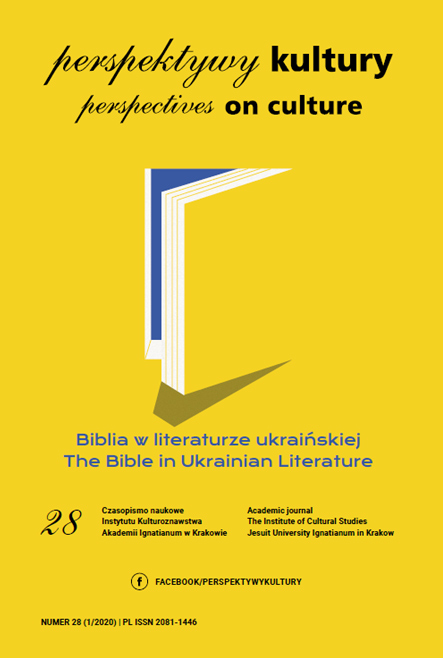“The Path of Love” and “The Path of the Cave” in Selected Works of Hans Christian Andersen
Abstract
In the article, the author discusses the “path of love” and “the path of the cave,” using selected works by Hans Christian Andersen. The Danish fairy tale writer masterfully shows how heroes anchored in a sensual world go a long way to find a world that escapes rational cognition. Most of his characters can easily be described as dynamic, because they change under the influence of powerful experiences. Those who attach more importance to beauty closed in a form devoid of deeper content are condemned. Andersen’s fairy tales have two audiences, children and adults. The former will understand the anecdote and the latter will see the metaphor. The works of the fairy tale writer show autobiographical threads, including his attitude to the Christian religion, in which the triad of truth, good, and beauty turns out to be extremely important.
References
Andersen, H.C. (1872). Beauty of form and beauty of mind. In Fairy Tales and Stories (H.P. Paull, Trans.). http://hca.gilead.org.il (Original work published 1860)
Andersen, H.C. (1872). The red shoes. In Fairy Tales and Stories (H.P. Paull, Trans.). http://hca.gilead.org.il (Original work published 1845)
Andrzejuk, A. (2000). Prawda o dobru. Problem filozoficznych podstaw etyki tomistycznej [The truth about good: The problem of the philosophical foundations of Thomas’s ethics]. Warsaw: Wydawnictwo UKSW.
Dernes-Sarnowska, M. (1996). Problem piękna w najnowszej polskiej myśli katolickiej [The problem of beauty in the latest Polish Catholic thought]. In S. Sarnowski (Ed.), Jedność i wielość [Unity and multiplicity]. Bydgoszcz: Wydawnictwo Uczelniane Wyższej Szkoły Pedagogicznej.
Duchliński, P. (2016). Epistemologiczne aspekty doświadczenie piękna trans-cendentalnego [Epistemological aspects of the experience of transcendental beauty]. In B. Bigaj-Zwonek, B. Haryszko, & S. Góra (Eds.), Sztuka – wartość – sacrum [Art – Value – Sacrum]. Krakow: Wydawnictwo WAM.
Eliade, M. (1998). Mit wiecznego powrotu [The Myth of the Eternal Return] (K. Kocjan, Trans.). Warsaw: Wydawnictwo KR.
Miller, K. & Cichocka, T. (2008). Czerwone trzewiki – taniec życia [Red shoes: A dance of life], In K. Miller & T. Cichocka, Bajki rozebrane [Fairy tales deciphered]. Łódź: Wydawnictwo JK.
Mortensen, K.P. (2006). Introduction. In H.C. Andersen (B. Sochańska, Polish Trans.), Andersen. Baśnie i opowieści [Fairy tales and stories] (Vol. 1). Poznań: Media Rodzina.
Ogłoza, E. (2014). Wokół opowieści Hansa Christiana Andersena. O radości czytania [Hans Christian Andersen’s Fairy Tales: On the joy of reading]. Katowice: University of Silesia Publishing House.
Plato. (2008). The Republic (B. Jowett, Trans.). http://www.gutenberg.org/ files/1497/1497-h/1497-h.htm (Original work published ca. 375 BCE)
Plato. (2008). Symposium (B. Jowett, Trans.). (Original work published ca. 385–370 BCE)
Plato. (2008). Timaeus (B. Jowett, Trans.). http://www.gutenberg.org/files/1572/1572-h/1572-h.htm (Original work published ca. 360 BCE) http://www.gutenberg.org/files/1600/1600-h/1600-h.htm
Ritter, C. (1910). Neue Untersuchungen über Platon [New studies on Plato]. München.
Sosnowski, L. (2011). Sztuka. Twórczość. Artysta. Wybór pism z filozofii ekspresji [Art – Creation – Artist: Selected essays on the philosophy of expression]. Krakow: Collegium Columbinum.
Stróżewski, W. (1992). Wykłady o Platonie [Lectures on Plato]. Krakow: Jagiellonian University Press.
Tatarkiewicz, W. (2007). Historia filozofii. Tom pierwszy. Filozofia starożytna i średniowiecza [History of Philosophy: Vol 1. Ancient and medieval philosophy]. Warsaw: Wydawnictwo Naukowe PWN.
Tendera, P. & Rubiś, W. (2016). Przedmioty świata materialnego na tle wybranych interpretacji platońskiej metafory jaskini [Objects of the material world against the background of selected interpretations of Plato’s metaphor of the cave]. Kwartalnik Filozoficzny, 44(1), 29–49.
Tendera, P. (2010). Światło–Piękno. Platona dwie drogi mądrości [Light – Beauty: Plato’s two paths of wisdom]. Kwartalnik Filozoficzny 37(1), 19–33.
Tuszyńska-Maciejewska, K. (1999). Platona pytanie o piękno [Plato’s question of beauty]. Collectanea Philologica 3, 123–130.
van Gennep, A. (2006). Obrzędy przejścia [Rites of passage] (B. Biały, Trans.). Warsaw: Państwowy Instytut Wydawniczy.
Wasylewski, S. (1921). On Romantic Love. Lviv.
Żuk, G. (2016). Kultura w kontekście wartości [Culture and Values], in: Grzegorz Żuk Edukacja aksjologiczna. Zarys problematyki [Axiological education: Introduction to the problem]. Lublin: University of Maria Curie-Skłodowska Publishing House.
Copyright (c) 2020 Jesuit University Ignatianum in Krakow

This work is licensed under a Creative Commons Attribution-NoDerivatives 4.0 International License.
Autor, zgłaszając swój artykuł, wyraża zgodę na korzystanie przez Wydawnictwo Uniwersystet Ignatianum z utworu na następujących polach eksploatacji:
- utrwalania utworu w formie papierowej, a także na nośniku cyfrowym lub magnetycznym;
- zwielokrotnienia utworu dowolną techniką, bez ograniczenia ilości wydań i liczby egzemplarzy;
- rozpowszechniania utworu i jego zwielokrotnionych egzemplarzy na jakimkolwiek nośniku, w tym wprowadzenia do obrotu, sprzedaży, użyczenia, najmu;
- wprowadzenia utworu do pamięci komputera;
- rozpowszechniania utworu w sieciach informatycznych, w tym w sieci Internet;
- publicznego wykonania, wystawienia, wyświetlenia, odtworzenia oraz nadawania i reemitowania, a także publicznego udostępniania utworu w taki sposób, aby każdy mógł mieć do niego dostęp w miejscu i czasie przez siebie wybranym.
Wydawca zobowiązuje się szanować osobiste prawa autorskie do utworu.





